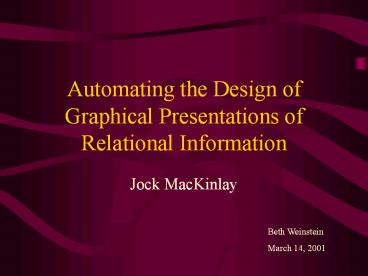Automating the Design of Graphical Presentations of Relational Information - PowerPoint PPT Presentation
1 / 17
Title:
Automating the Design of Graphical Presentations of Relational Information
Description:
Title: Automating the Design of Graphical Presentations of Relational Information Author: Beth Weinstein Last modified by: Beth Weinstein Created Date – PowerPoint PPT presentation
Number of Views:147
Avg rating:3.0/5.0
Title: Automating the Design of Graphical Presentations of Relational Information
1
Automating the Design of Graphical Presentations
of Relational Information
- Jock MacKinlay
Beth Weinstein March 14, 2001
2
Paper Outline
- Introduction
- Expressiveness
- Effectiveness
- Composition
- Implementation
3
Introduction
- Previously application designers had to
anticipate every situation and predesign
graphic designs - In related work, the BHARAT system, automatically
creates 2D graphical designs based on the data
type. For example, the system automatically
chose to show the data as a line chart if the
data was continuous.
4
Introduction
- MacKinlays goal was to build a presentation tool
(APT) that would create a graphic design that
would express relations and their basic
properties effectively - APT would have the best way to view 2-D data
using expressiveness and effectiveness criteria.
The paper focuses on 2-D static presentations of
relational data (scatter plots, bar charts, etc.)
5
Introduction
- Three types of data
- ordinal (Monday, Tuesday, Wednesday)
- nominal (United States, Mexico, Canada)
- quantitative (1, 2, 3)
- Problems could arise when there are multiple and
conflicting criteria for a data set
6
Expressiveness Criteria
identify graphical languages that express the
desired information
- Expressive if
- include all data in the set
- include only data from the set
7
Expressiveness Criteria
8
Effectiveness Criteria
identify which graphical languages is most
effective at using the output and human
capabilities
- Based on human perceptual capabilities
- Graphical design interpreted quickly and
accurately - Cleveland and McGills conjectural theory -
different graphical designs are interpreted by
people with varying accuracy
9
Expressiveness Criteria
10
Effectiveness Criteria
11
Composition
- Merge different encoding techniques not usually
combined
12
Implementation
- Partitioning
- A divide and conquer algorithm
- Partition on most important element
- Selection
- For each partition, a list of graphic design is
generated based on expressiveness criteria - Then, the list is ordered by the effectiveness
criteria - Composition
- Each partitions graphic design is tested to see
if they both can be applied, if not the next most
effective graphic design is used
13
Favorite Sentence
an important responsibility of a user interface
is to make intelligent use of human visual
abilities and output media whenever it presents
information to the user.
14
Reference Notes
- MacKinlay - Ph.D. dissertation
- Cleveland and McGill
- General, well-cited references
- Tufte
- Knuth
15
Critique
- Strengths
- Proves that a graphical design may not be
appropriate for all types of data - Gives a criteria for perceptual tasks
- Weaknesses
- Vague on how extended Cleveland and McGills
criteria - Composition algebra unnecessary
16
Contributions
- Provides a ranking of perceptual tasks for
nominal, ordinal, and quantitative data - Contributes a new graphical designs by combining
perceptual tasks - Creates a tool that will create expressive and
effective graphical designs based on the data
17
(No Transcript)





























![Investigations on Automatic Behavior-based System Design [A Survey on] Hierarchical Reinforcement Learning PowerPoint PPT Presentation](https://s3.amazonaws.com/images.powershow.com/6219810.th0.jpg?_=20150306026)

